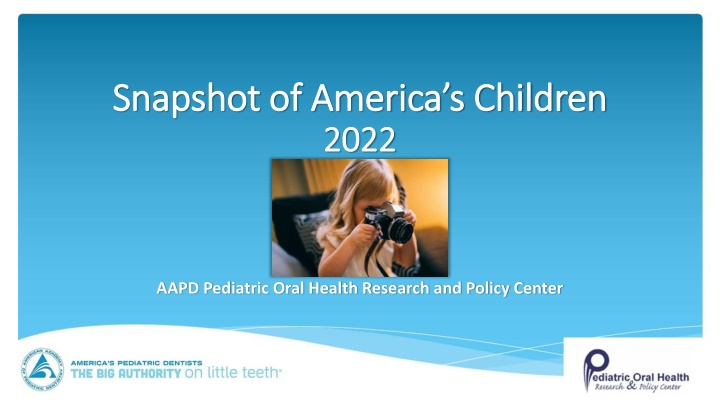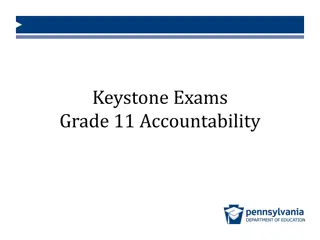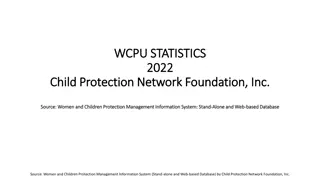
Insights into American Children: A Snapshot of Demographics and Trends
This comprehensive report delves into various aspects concerning America's children in 2022, covering child demographics, family economics, health habits, oral health, and more. It includes statistics on market shares, child populations, U.S. demographics by race, and community involvement. Engage with quiz questions about the future age trend and youth crime statistics to enhance your understanding of the current landscape.
Download Presentation

Please find below an Image/Link to download the presentation.
The content on the website is provided AS IS for your information and personal use only. It may not be sold, licensed, or shared on other websites without obtaining consent from the author. If you encounter any issues during the download, it is possible that the publisher has removed the file from their server.
You are allowed to download the files provided on this website for personal or commercial use, subject to the condition that they are used lawfully. All files are the property of their respective owners.
The content on the website is provided AS IS for your information and personal use only. It may not be sold, licensed, or shared on other websites without obtaining consent from the author.
E N D
Presentation Transcript
Snapshot of Americas Children Snapshot of America s Children 2022 2022 AAPD Pediatric Oral Health Research and Policy Center
Topics Topics 1. Child Demographics 2. Family and Community Economic Standing Education 3. Health Habits 4. Oral Health 5. Dental Visits 6. Parent Perspectives
Market Share Market Share Age Group Under 2 2 to 4 5 to 17 Under 17 Pediatric Dentist Share 43% 40% 23% 26%
Child Demographics Child Demographics
Quiz Question 1 Quiz Question 1 Is the U.S. population expected to become older or younger by 2050? a) Neither. It will stay about the same. b) Younger. The average age of Americans will go down. c) Older. The average age will go up. d) By 2050, everyone will look young to me!
Child Population Child Population * Number of children in the U.S. in 2020: 72.8 million * This represents 22% of the total population * Number of children in the U.S. projected for 2050: 78.2 million * This represents 20% of the total population
U.S. Demographics U.S. Demographics Race and Ethnicity Percentages Hispanic Non-Hispanic White Black American Indian/Alaska Native Asian Native Hawaiian/Pacific Islander Two or more races 2022 25.8 2050 30.8 49.2 13.9 0.8 5.4 0.2 4.8 39.4 13.9 0.7 7.2 0.2 7.7
Family and Community Family and Community
Quiz Question 2 Quiz Question 2 During the last ten years, youth ages 12-17 involved in serious crimes either as a victim or an offender has: a) Increased b) Decreased c) Stayed the same d) Take my wallet and cellphone, just please don t hurt me
Family and Community Family and Community * Serious violent crime victimization of youth ages 12 17 in 2020 6 per 1,000 * Serious violent crime victimization of youth ages 12 17 in 2008 12 per 1,000 * Youth offenders ages 12 17 involved in serious crimes in 2020 8 per 1,000 * Youth offenders ages 12 17 involved in serious crimes in 2008 14 per 1,000
Economic Standing Economic Standing
Quiz Question 3 Quiz Question 3 What percentage of U.S. children are classified as food insecure ? a) One in four. b) One in six. c) One in ten. d) None. Pass the donuts.
Food Insecurity Food Insecurity *Low food security: reports of reduced quality, variety, or desirability of diet. Little or no indication of reduced food intake. *Very low food security: Reports of multiple indications of disrupted eating patterns and reduced food intake. *Food desert: parts of the country devoid of fresh fruit, vegetables, and other healthy foods, typically in impoverished areas. *Food swamp: neighborhoods saturated with fast food chains, corner stores, and other unhealthy food providers.
Economic Standing Economic Standing * Children living in poverty in 2020: 16% * Households with children reporting shelter cost burden, crowding, and/or physically inadequate housing in 2019: 38%
Education Education
Education Education * Children who speak a language other than English at home: 23% * Children who speak a language other than English at home and who have difficulty speaking English: 4% * Children ages 3-5 who were read to 3 or more times in the last week: 85%
Health Habits Health Habits
Weight and Weight Perceptions Weight and Weight Perceptions Obese: 15% Overweight: 16% Perceives Overweight: 32% Trying to Lose Weight: 47% 70% 60% 60% 50% 38% 34% 40% 25% 30% 20% 10% 0% Described Themselves as Overweight Trying to Lose Weight
Quiz Question 4 Quiz Question 4 What is the average amount of screen time per day that children have? a) Less than an hour b) Between 3 and 4 hours c) Between 6 and 7 hours d) 24 hours. They re always on their iPads!
Screen Time Screen Time Age Average Number of Hours per Age Group 0:42 2:40 3:00 4:44 7:22 0-2 2-4 5-8 9-12 13-18
Quiz Question 5 Quiz Question 5 How have the health habits of U.S. teens changed between 2009 and 2019? a) Smoking, alcohol and drug use have all increased. b) Smoking has decreased; use of alcohol and drugs has increased. c) Smoking and alcohol have decreased; drug use has increased. d) Smoking, alcohol and drug use have all decreased.
Use of Alcohol Use of Alcohol Students who reported having 5 or more alcoholic beverages in a row in the past 2 weeks 2005 2019 8th grade 12th grade 11% 4% 29% 14%
Use of Use of Alcohol 2021 Alcohol 2021 60.00% 55.30% 46.50% 50.00% 40.70% 40.00% 28.50% 30.00% 20.50% 17.20% 20.00% 10.00% 0.00% Eighth graders Tenth graders Twelfth graders 2020 2021
Smoking Smoking Students who reported smoking cigarettes daily in the past 30 days 2005 2019 8th grade 12th grade 4% 2% 16% 2%
Vaping Nicotine 2021 Vaping Nicotine 2021 40.00% 34.50% 35.00% 30.70% 30.00% 26.60% 25.00% 19.50% 20.00% 16.60% 12.10% 15.00% 10.00% 5.00% 0.00% Eighth grade Tenth grade Twelfth grade 2020 2021
Quiz Question 7 Quiz Question 7 How many high school seniors reported having used prescription opioids non-medically? a) 1 in 100 b) 1 in 25 c) 1 in 8 d) All of them. Except my kids.
Use of Drugs Use of Drugs Students who reported using illicit drugs in the past 30 days 2005 2019 8th grade 12th grade 8% 9% 23% 25%
Mental Health Impact Mental Health Impact
General Health and Oral Health General Health and Oral Health Tooth decay is associated with: * Life-threatening infection * Significant pain * Chewing difficulty * Malnutrition * Delayed or insufficient growth * Poor speech articulation * Poor sleep habits * Low self-esteem * Social ostracism * Poor school performance * Diminished quality of life
Oral Health Oral Health
Caries Prevalence by Age Caries Prevalence by Age Age of Child Total Caries Untreated Caries 2 5 18% 5% 6 11 45% 15% 12 19 54% 13% 2 19 43% 13%
Quiz Question 8 Quiz Question 8 Which race or ethnicity had the highest prevalence of total dental caries in 2021? a) White b) Black c) Hispanic d) Asian e) American Indian/Alaska Native
Caries Prevalence by Age, Race and Caries Prevalence by Age, Race and Ethnicity, and Poverty Status Ethnicity, and Poverty Status Source: America s Children: Key National Indicators of Well-Being, 2020, www.childstats.gov
Dental Visits Dental Visits
Dental Visits by Age Dental Visits by Age
Dental Visits by Race/Ethnicity Dental Visits by Race/Ethnicity
Dental Visits by Poverty Status Dental Visits by Poverty Status
Dental Visits by Insurance Type Dental Visits by Insurance Type 94% 100% 90% 90% 83% 90% 80% 69% 67% 64% % of Children Surveyed 70% 55% 51% 60% 51% 50% 35% 40% 30% 20% 10% 0% Private Public None Private Public None Private Public None Private Public None 2-4 years 5-17 years 2-4 years 5-17 years 2008 2018 Age, Year, and Insurance Type
Parent Perspectives Parent Perspectives
Parent Referrals Parent Referrals Children Offered Advice from Their Healthcare Provider about Need for a Dental Visit Children ages 2 5 Children ages 6 12 Children ages 13 17 Children ages 2 17 57% 54% 46% 52%
Quiz Question 10 Quiz Question 10 If children have their first dental visit at four years or younger, rather than four years or older, their parents benefit from an average cost savings of: a) $360 b) $695 c) No savings, due to the cost of more visits d) Priceless!
Snapshot of Americas Children Snapshot of America s Children 2022 2022 AAPD Pediatric Oral Health Research and Policy Center Robin Wright, PhD: rwright@aapd.org



















